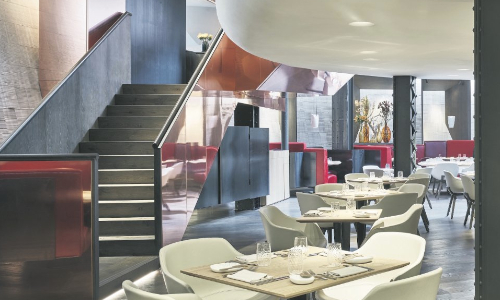Review: Eneko at One Aldwych

Azurmendi, a short drive from the centre of Bilbao, is one of those restaurants food groupies plan holidays around. Eneko Atxa’s three-Michelin star venue is like an epicurean Bond lair, a glass cube squatting in its own lavish herb garden, which guests are obliged to peruse before they begin their multitude of courses. Atxa himself is culinary royalty, the equivalent of a Messi or Ronaldo, or at least an Ibrahimovic; his restaurant peaked at 16 in this year’s coveted “50 Best” list.
So you’d think the arrival of a second outpost in his empire – the first restaurant to bear his name – would be the cause of great fanfare. Yet the opening of Eneko, in the bowels of One Aldwych, has been a muted affair: no hordes jostling in line to get in, no heavy-hitting critics with day-one reservations, no stream of tweets from adoring visitors. I went on Friday night, shortly after the official launch (it’s been in “soft opening” for a few weeks), and there were plenty of spare tables. At 110 covers it’s pretty big, but you’d have thought the bloggers alone would pack it out.
Eneko is pitched as a diffusion-line of Azurmendi, borrowing aspects of that restaurant’s experiential approach – the dry ice poured over a starter, butter “infused” with basil in a pestle and mortar at your table – but paring it back, making it more “relaxed”. The result is a restaurant that shows flashes of brilliance but leaves you in no doubt this is a distant cousin of Azurmendi rather than a hip younger sibling.
The dining room is vastly different from the dated Axis restaurant it replaces. Maximum effort has gone into making it look like something other than a basement, with a sizeable chunk of the ceiling having been removed to create an industrial-looking funnel, with a mezzanine bar (empty on my visit) crouched above. The walls taper outwards to reflect light into the room and give the illusion of more space, while a giant staircase, clad in polished copper, links to the outside world.
The tables are irregular triangles, with cherry-red, high-backed banquettes. It draws heavily from the Tom Dixon playbook, although apparently the furniture is made back home in the Basque Country. It’s almost a success: everything looks smart in isolation, but collectively it has the air of a showroom rather than a living, breathing restaurant.
Our first dish was ‘Txerri Boda Pork Festival’, referring to a celebration that takes place at the start of the Basque pig slaughtering season, where families gather to bleed a pig to death. It’s closely linked to the Feast of Saint Martin and there’s a saying in Spanish: “Every pig gets its St Martin”, which is similar to our reaping what you sow (there are variations on the theme throughout Europe, with the Irish substituting the pig for a cockerel and splashing its blood in the four corners of the home). I’m not sure what my particular pig’s crime was, but it ended up as three dainty milk buns filled with chorizo, black pudding and Iberico ham, respectively. It was served in a heavy box with a wooden pig’s head mounted on the lid, the snout propped theatrically on the table to glare at you as you eat, reminding you of the swine that died for your ham.
Anchovy tempura was more straightforward, a few light slivers served in a paper cone, with blobs of aioli and a ramekin of tomato powder. Nice, but charging £15 for it is an outrage. ‘Memories of the Bay of Biscay’ (I know, right?) consists of a dressed rock oyster, a crab-shell filled with rich, dark meat, and a porcelin sea urchin packed with gloopy prawn tartare. Only the crab really impressed and, at £16, you really expect a better hit-rate than that. The addition of dry ice might have worked in a restaurant where theatrics are de rigueur, but here it seems out of tune with its surroundings, ignominiously pining for an Instagram pic.
Our mains had the outward appearance of small portions but were in fact just incredibly dense, like tiny collapsed stars. Cod-tripe Bizkania (either an alternative spelling or a typo of vizcania) is a traditional stew filled not with the animal’s stomach but its natatory bladder (the gas-filled organ used to control buoyancy), giving it a spongy texture unlike any other part of the fish. It’s thick and tasty and oh so heavy and, after the first few spoonfuls, cutlery and small plates will start to orbit around your new gravitational field.
Oxtail with mushroom emulsion is in the same ballpark: a squat, fierce pile of meat, dark and musky, excellent in small doses but treacherously filling. Desserts felt like an after-thought: a lacklustre raspberry macaron with basil ganache and a perfectly adequate but wholly unexciting vanilla bread pudding, albeit served with excellent sheep’s milk ice cream.
Eneko is an ungainly mix of haute cuisine and traditional staples that never quite gels. The edible flowers sprinkled hither and thither feel like they belong in a different world to the hearty traditional dishes, and despite being generally well put together, it didn’t justify a bill that topped £170 for two. Atxa is an indisputably brilliant chef, but he’s only going to be visiting Eneko once a month; his priorities clearly still lie in the Basque Country and I’m afraid it shows.
First published in City A.M.

